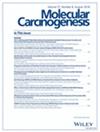单泛素化的 H2B 是甲醛的主要染色质靶标,对 S 期检查点信号传导和基因组稳定性非常重要
IF 3
2区 医学
Q3 BIOCHEMISTRY & MOLECULAR BIOLOGY
引用次数: 0
摘要
甲醛(FA)是一种人类致癌物质,环境中的接触无处不在,而且在体内也会形成大量甲醛。甲醛的基因毒性源于它与 DNA-NH2 基团的反应性。组蛋白赖氨酸是染色质中醛反应性氨基的另一个来源,然而,人们对染色质/组蛋白对 FA 的损伤反应及其生物学意义还知之甚少。我们研究了经 FA 处理的人肺细胞中的组蛋白翻译后修饰,发现与活跃或不活跃染色质相关的大多数最突出的小赖氨酸修饰均保持不变。FA适度降低了H3K9和H3K27乙酰化以及H2A-K119单泛素化,但却导致H2B-K120单泛素化的惊人严重损失,尤其是在原代细胞和干样细胞中。H2Aub1的减少反映了其泛素化速度较慢,这与FA损伤蛋白的K48-多泛素化导致泛素可用性降低有关。H2Bub1的耗竭部分是由于其被ATXN7L3相关的去泛素化酶快速去泛素化,而且与DNA损伤信号无关,这表明这是一种直接的染色质损伤反应。对H2Bub1丰度的控制表明,它对ATM和ATR信号的稳健、S期检查点的高效、抑制有丝分裂期未复制DNA的传递和微核的形成非常重要。我们的研究结果确定了H2B去泛素化是FA诱导的主要染色质损伤反应,可调节S期检查点信号传导和基因组稳定性。本文章由计算机程序翻译,如有差异,请以英文原文为准。
Monoubiquitinated H2B, a Main Chromatin Target of Formaldehyde, Is Important for S‐Phase Checkpoint Signaling and Genome Stability
Formaldehyde (FA) is a human carcinogen with ubiquitous environmental exposures and significant endogenous formation. Genotoxic activity of FA stems from its reactivity with DNA‐NH2 groups. Histone lysines are another source of aldehyde‐reactive amino groups in chromatin, however, chromatin/histone damage responses to FA and their biological significance are poorly understood. We examined histone posttranslational modifications in FA‐treated human lung cells and found that the majority of the most prominent small lysine modifications associated with active or inactive chromatin were unchanged. FA moderately decreased H3K9 and H3K27 acetylation and H2A‐K119 monoubiquitination but caused surprisingly severe losses of H2B‐K120 monoubiquitination, especially in primary and stem‐like cells. H2Aub1 decreases reflected its slower ubiquitination linked to a lower ubiquitin availability due to K48‐polyubiquitination of FA‐damaged proteins. Depletion of H2Bub1 resulted from its rapid deubiquitination in part by ATXN7L3‐associated deubiquitinases and was independent on DNA damage signaling, indicating a direct chromatin damage response. Manipulations of H2Bub1 abundance showed that it was important for robust ATM and ATR signaling, efficient S‐phase checkpoint, and suppression of mitotic transmission of unreplicated DNA and formation of micronuclei. Our findings identified H2B deubiquitination as a major FA‐induced chromatin damage response that regulates S‐phase checkpoint signaling and genome stability.
求助全文
通过发布文献求助,成功后即可免费获取论文全文。
去求助
来源期刊

Molecular Carcinogenesis
医学-生化与分子生物学
CiteScore
7.30
自引率
2.20%
发文量
112
审稿时长
2 months
期刊介绍:
Molecular Carcinogenesis publishes articles describing discoveries in basic and clinical science of the mechanisms involved in chemical-, environmental-, physical (e.g., radiation, trauma)-, infection and inflammation-associated cancer development, basic mechanisms of cancer prevention and therapy, the function of oncogenes and tumors suppressors, and the role of biomarkers for cancer risk prediction, molecular diagnosis and prognosis.
 求助内容:
求助内容: 应助结果提醒方式:
应助结果提醒方式:


